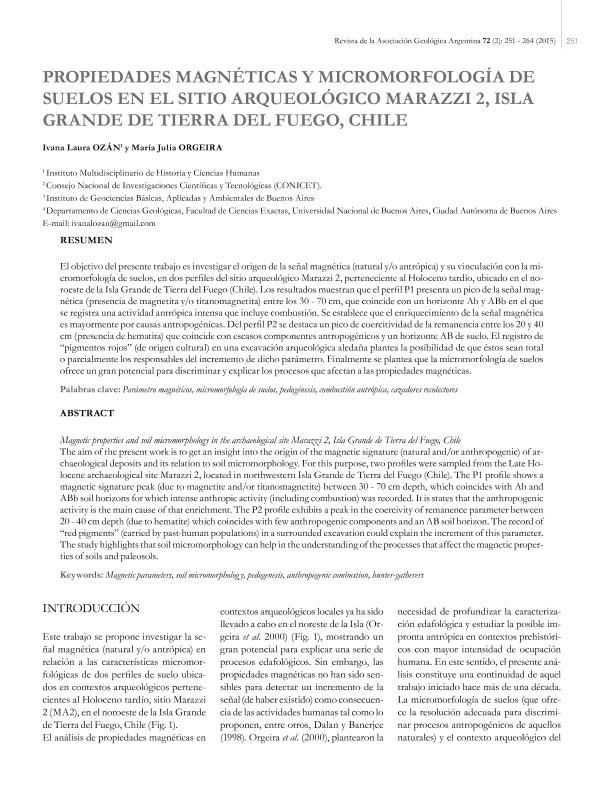Artículo
El objetivo del presente trabajo es investigar el origen de la señal magnética (natural y/o antrópica) y su vinculación con la micromorfología de suelos, en dos perfiles del sitio arqueológico Marazzi 2, perteneciente al Holoceno tardío y ubicado en el noroeste de la Isla Grande de Tierra del Fuego (Chile). Los resultados muestran que el perfil P1 presenta un pico de la señal magnética (presencia de magnetita y/o titanomagnetita) entre los 30 - 70 cm, que coincide con un horizonte Ab y ABb en el que se registra actividad antrópica intensa que incluye combustión. Se establece que el enriquecimiento de la señal magnética es mayormente por causas antropogénicas. Del perfil P2 se destaca un pico de coercitividad de la remanencia entre los 20 y 40 cm (presencia de hematita) que coincide con escasos componentes antropogénicos y un horizonte AB de suelo. El registro de “pigmentos rojos” (de origen cultural) en una excavación arqueológica aledaña plantea la posibilidad de que éstos sean total o parcialmente los responsables del incremento de dicho parámetro. Finalmente se plantea que la micromorfología de suelos ofrece un gran potencial para discriminar y explicar los procesos que afectan a las propiedades magnéticas. The aim of the present work is to get an insight into the origin of the magnetic signature (natural and/or anthropogenic) of archaeological deposits and its relation to soil micromorphology. For this purpose, two profiles were sampled from the Late Holocene archaeological site Marazzi 2, located in northwestern Isla Grande de Tierra del Fuego (Chile). The P1 profile shows a magnetic signature peak (due to magnetite and/or titanomagnetite) between 30 - 70 cm depth, which coincides with Ab and ABb soil horizons for which intense anthropic activity (including combustion) was recorded. It is states that the anthropogenic activity is the main cause of that enrichment. The P2 profile exhibits a peak in the coercivity of remanence parameter between 20 - 40 cm depth (due to hematite) which coincides with few anthropogenic components and an AB soil horizon. The record of “red pigments” (carried by past-human populations) in a surrounded excavation could explain the increment of this parameter. The study highlights that soil micromorphology can help in the understanding of the processes that affect the magnetic properties of soils and paleosols.
Propiedades magnéticas y micromorfología de suelos en el sitio arqueológico Marazzi 2, Isla Grande de Tierra del Fuego, Chile
Título:
Magnetic properties and soil micro-morphology in the archaeological site Marazzi 2, Isla Grande de Tierra del Fuego, Chile
Fecha de publicación:
06/2015
Editorial:
Asociación Geológica Argentina
Revista:
Revista de la Asociación Geológica Argentina
ISSN:
1851-8249
Idioma:
Español
Tipo de recurso:
Artículo publicado
Clasificación temática:
Resumen
Archivos asociados
Licencia
Identificadores
Colecciones
Articulos(IGEBA)
Articulos de INSTITUTO DE GEOCIENCIAS BASICAS, APLICADAS Y AMBIENTALES DE BS. AS
Articulos de INSTITUTO DE GEOCIENCIAS BASICAS, APLICADAS Y AMBIENTALES DE BS. AS
Citación
Ozán, Ivana Laura; Orgeira, Maria Julia; Propiedades magnéticas y micromorfología de suelos en el sitio arqueológico Marazzi 2, Isla Grande de Tierra del Fuego, Chile; Asociación Geológica Argentina; Revista de la Asociación Geológica Argentina; 72; 2; 6-2015; 251-264
Compartir




